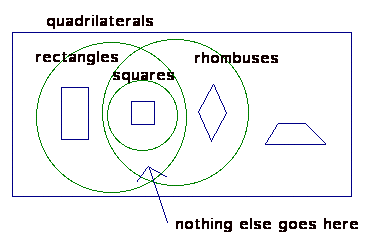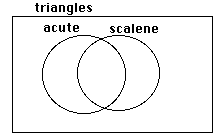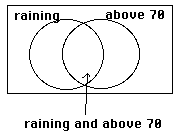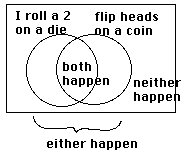
Sets are used to describe how defined mathematical objects relate to each other. For example, all squares are rectangles, so the set of all squares is a subset of the set of all rectangles.

All squares are also rhombuses (quadrilaterals with 4 equal sides), so the set of all squares is a subset of the set of all rhombuses. If we put these on a diagram together, we get that the set of all squares is in the intersection of the rectangles and rhombuses. It is also true that if a quadrilateral is both a rectangle and a rhombus, then it must be a square, so it is impossible to find any non-square examples to put in the intersection. A trapezoid is an example of something that is neither a rhombus nor a rectangle.
You may find it useful to read about how sets are used to describe the relationships among types of triangles. Note that the homework problems that follow this page are intended for the geometry unit of this course, and are not currently assigned
The homework for today is similar:
Fill in the following set diagram with examples every where an example should be:

This problem is due this Friday
You will also use sets in math 247 in studying probability.
For example, If you have two intersecting conditions for an event:

that it is raining on a specific day, and that the high temperature is above 70° on that specific day, then the intersection: that it will rain and the high temp will be above 70° is less likely than either condition by itself, because that condition is more restrictive: it is a subset of each of the other two conditions. This isn't a probablilty peoblem that we are likely to tackle in this class, because the events: it is raining, and that the high temperature is above 70° are not independent events: rain affects the temperature, but we will work on some similar probability situations that are easy to solve, and where we have intersecting conditions.
In probability, we can multiply together probabilities when either the conditions are independent, or when the probability of the second is calculated, assuming that the first occurs. A situation where two events are independent is if I roll a die and flip a coin:

The probability of rolling 2 on a die is 1/6
The probability of flipping heads on a coin is 1/2
The probability of both happening when you roll a die and flip a coin is (1/2)(1/6)=1/12
A really important idea in probability is complement. If there are two complementary outcomes, then their probabilities add to 1. So:
The probability of not rolling 2 on a die is 5/6
The probability of not flipping heads on a coin is 1/2
The probability of not both rolling a 2 and getting heads is 11/12
But the probability of getting neither a 2 nor heads is (5/6)(1/2)=5/12
A fun probability problem that you will probably see in math 247 is the Birthday problem. It is a good example of using the complement of a set.